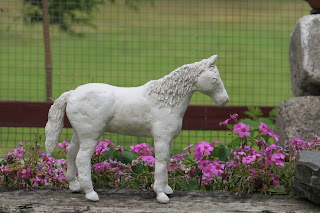I've only been modelling with ADC for a few months now, but I've learned a lot in that time and I thought I'd share some of what I've learned with you.
ADC Brands I have tried.
DAS air dry clay is what I started with, and I have still to find anything better. It is what the Americans refer to as a "paper clay". It is quite fibrous and sticky, and initially I found it hard to work with, but soon found some techniques to make life easier, (see below.)
It dries well, with no cracking and is very lightweight and strong. Scrumpy was made with Das and is much lighter than other models I have made.
One day we went to Smyths toyshop and I bought some cheap ADC from there, it seems to have been made in China, it is terracotta in colour and crumbles and cracks when dry. The only way to stop it cracking was to mix it with DAS in a ratio of two parts DAS to one part cheap clay. As an experiment I mixed it with PVA glue, but it still cracked, and took longer to dry.
I also bought some of Hobbycraft's own brand ADC, it is white and very soft and about the same price as DAS. It's smooth and nice to work with, but I couldn't get it to dry without cracking, so once again I found myself mixing it with DAS in the same ratio as before.
Models made with the Clay/DAS mix are much heavier than ones made with just DAS. I don't know how well they will last in comparison, I suspect they will tend to be a tad more brittle, but theoretically they should be OK.
Tips and Techniques
Always have a small bowl of water on your workspace, and dip your fingers in frequently, ADC sticks to dry fingers and is almost impossible to work with, but wet fingers will stay clean, and make smoothing and blending clay much easier.
A small spray bottle is your best friend. I always spray a little water into my clay bag before I put it away.
During hot weather a quick squirt can stop your project from drying out while you're working on it.
Don't expect to finish a sculpture in one day, build it up a little at a time, let it dry overnight and then add more clay. I take weeks to finish models, so I have several projects on the go at once. Also there's nothing worse than getting one part of a model exactly how you want it, and then sticking your finger in the wet clay and ruining it when you move on to a different part of the model.
I think this way of working also helps to prevent the clay cracking, which seems to be a problem for a lot of people.
Soften up small batches of clay by kneading them (with wet fingers!) and then keep them in plastic bags, give them a quick spray of water before packing them away at the end of the day.
Keep your clay in slightly damp plastic bags inside an airtight container ( plastic ice cream tubs are ideal) keep them in a dark cool place, as sunlight can reduce the working life of your clay.
Happy Sculpting!

























